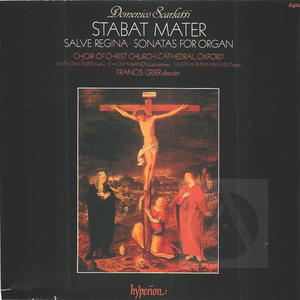
Domenico Scarlatti: Stabat Mater
composed by Domenico Scarlatti, 1685-1757; conducted by Francis Grier; produced by Mark Brown, 1962-; performed by Anthony Pleeth, Chi-Chi Nwanoku, Timothy Bryam-Wigfield, Francis Grier, Charles Harris and Nicholas Clapton, Choir of Christ Church Cathedral, Oxford (Hyperion), 53 mins
Details
- Field of Interest
- Classical Music
- Composer
- Domenico Scarlatti, 1685-1757
- Conductor
- Francis Grier
- Content Type
- Music recording
- Duration
- 53 mins
- Recording Engineer
- Anthony Howell
- Ensemble
- Choir of Christ Church Cathedral, Oxford
- Format
- Audio
- Sub Genre
- Stabat Mater, Sonata, Motet
- Label
- Hyperion
- Performer
- Anthony Pleeth, Chi-Chi Nwanoku, Timothy Bryam-Wigfield, Francis Grier, Charles Harris, Nicholas Clapton
- Producer
- Mark Brown, 1962-
- Date Recorded
- 1985-07-01
- Review
- The choral music of Domenico Scarlatti is almost unknown, a mere footnote to the hundreds of concise yet radically innovative keyboard sonatas that were among the first works of the late Baroque/early Classical period to receive frequent performances. This disc from Belgium's Ricercar label, with a truly pan-European group of singers called Vox Luminis, is labeled as a performance of the Scarlatti Stabat Mater (less familiar even than that of his father, Alessandro Scarlatti), but it actually includes four choral works of various kinds, plus two keyboard sonatas played on the organ. All, except for the opening Te Deum laudamus, are as conservative as the keyboard sonatas are radical -- polyphonic, rarely operatic, and drawing on aspects of Renaissance music and styles of the early Baroque. They may have been early works, written in Rome before Scarlatti's departure for the Iberian peninsula, but this is not certain. What's most striking is that, although conservative, the music shows a good deal of Scarlatti's characteristic imagination. Consider the Stabat Mater itself, specified as a setting for 10 voices and continuo. That would lead the listener to expect two choirs of five voices each, or some other subdivision, but that's not the case; it's an actual 10-part polyphonic setting of the text, with constantly shifting configurations of the 10 voices, a moving setting of "Juxta crucem" in which onlookers seem to add their voices in mourning, and a slam-bang finale in which all spring into action to depict the soul "inflamed and burning" at the day of judgment and its ascent into the "glory of Paradise." Vox Luminis has a rather dry sound with one voice per part -- normally undesirable in music where choirs were available, and destructive of the contrasts in the four-voice Miserere that closes the program, with its alternation among choral, solo, and chant sections. In the Stabat Mater, however, it works quite well in clarifying the complex textures of the work. Recommended for those enamored of Domenico Scarlatti's peculiar genius, especially those tolerant of one-voice-per-part approaches. ~ James Manheim, All Music Guide
- Subject
- Classical Music, Music & Performing Arts, Baroque, Barroco
- Keywords and Translated Subjects
- Barroco
